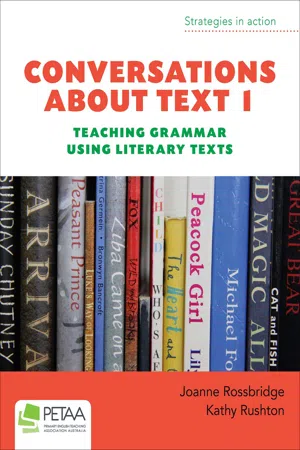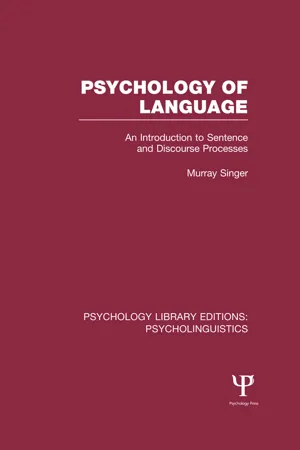Coherences within Sentences
Coherence within sentences refers to the logical and meaningful connection between different parts of a sentence. This includes the use of appropriate grammar, syntax, and cohesive devices to ensure that the sentence is clear and understandable. Achieving coherence within sentences is essential for effective communication and comprehension in language and linguistics.
6 Key excerpts on "Coherences within Sentences"
- eBook - ePub
- M.A.K. Halliday, Ruqaiya Hasan(Authors)
- 2014(Publication Date)
- Routledge(Publisher)
...B. Priestley, Vol 2), Heinemann. Cohesive ties, especially those with the immediately preceding text, are only one source for the information that the reader or listener requires. Both situational and more remote textual information are necessary components. But it is surprising how much can often be recovered simply from the presuppositions carried by the cohesive elements. The ongoing continuity of discourse is a primary factor in its intelligibility. This illustrates the meaning of cohesion as a whole. It provides, for the text, which is a semantic unit, the sort of continuity which is achieved in units at the grammatical level – the sentence, the clause and so on – by grammatical structure. Like everything else in the semantic system, cohesive relations are realized through the lexicogrammar, by the selection of structures, and of lexical items in structural roles. Our intention in this book has been to survey the lexicogrammatical resources in question, and show their place in the linguistic system. But the cohesive relations themselves are relations in meaning, and the continuity which they bring about is a semantic continuity. This is what makes it possible for cohesive patterns to play the part they do in the processing of text by a listener or a reader, not merely signalling the presence and extent of text but actually enabling him to interpret it and determining how he does so. 7.3 The meaning of different kinds of cohesion We have discussed cohesion under the five headings of reference, substitution, ellipsis, conjunction and lexical cohesion. The classification is based on linguistic form; these are the categories of cohesion that can be recognized in the lexicogrammatical system...
- eBook - ePub
- Michael Toolan(Author)
- 2014(Publication Date)
- Routledge(Publisher)
...2 Cohesion: making text In this chapter we shall be examining the linguistic means by which sentences are woven together to make texts, a process called cohesion. The starting-point for such a study is the view that texts are made up of sentences, just as houses are made up of bricks, posts, beams, and so on. But that is clearly not the whole story in either case. You don’t build a house simply by bringing bricks, beams, etc. together; you have to fasten or bond them together in a variety of ways. The same applies to texts: sentences must be bound together and cross-linked. We shall assume that a text is an integrated structure, just as surely as a house is: both need various kinds of fastening devices to hold their parts together. In the case of a house, those devices or binding agents may be potentially visible (nails, screws, brackets, adhesives) while one major means is invisible (gravity). In the case of texts, all the cohesive ties are invisible: they are implicit but palpable connections between words in different sentences. Cohesion thus refers to all the linguistic ways in which the words of a passage, across sentences, cross-refer or link up. It is important to bear in mind from the outset that we are particularly considering links between or across sentences, and not links within sentences. So we are not considering the link between Kim and she in the following sentence: Kim collapsed into the chair because she was exhausted. You may wonder why we are playing down the very clear connection between Kim and she in the cited sentence. The reason is that the choice of she is so predictable. There is a very strong preference for the ‘second mention’ of Kim in the above sentence to be via a pronoun (feminine or masculine, to match Kim’s gender). There is a very strong ‘default’ choice, of the pronoun, and we shall treat such a choice as a matter of sentence grammar, not a matter of the textual grammar that is cohesion...
- eBook - ePub
Conversations aboutext 1
Teaching grammar using literary texts
- Joanne Rossbridge, Kathy Rushton(Authors)
- 2010(Publication Date)
...Chapter Eight Grammatical Knowledge to Respond to Whole Texts – Cohesion How can we help students to use grammatical knowledge to respond to text? In previous chapters we have shown how grammatical features can be taught in context to support students' understanding of text and this sometimes takes place at the level of the clause, sentence or paragraph. However it is at the level of text that cohesion must be taught. Cohesive devices are ways of making a text fluent and readable; they are the tools good writers use for linking their ideas into a coherent whole. In this sense even though noun groups, verbal groups, adverbials and single words may constitute cohesive devices it is their use across the text; the 'pattern across a text', which makes the particular groups or words cohesive. Skilled writers also use Theme of clause to develop themes and support the reader across the stages of a text from the level of the clause through to the whole text level. It is here that nominalisation and the ability to condense ideas in an extended noun group or complex sentence is so important, as these are the tools which allow a writer to focus the reader's attention on particular information by placing it in the Theme position. What else do you need to know about cohesion? One of the things that a fluent reader does is to carry meaning across chunks of text. Less fluent readers tend not to do this, but to focus instead on much smaller units of meaning, such as individual words. Being able to carry an idea right through a text is dependent on being able to process the cohesive links between sentences. A native speaker has an intuitive understanding of how cohesion operates, but second language learners may not have developed this understanding fully. Helping readers to be aware of cohesive links will help them to see the wholeness of a text and so understand it more easily...
- eBook - ePub
Psychology of Language (PLE: Psycholinguistics)
An Introduction to Sentence and Discourse Processes
- Murray Singer(Author)
- 2013(Publication Date)
- Psychology Press(Publisher)
...5 Understanding Coherent Discourse Language messages consist of units of many levels of complexity, including words, phrases, clauses, and sentences. However, people seldom need to make judgments about isolated linguistic units. Rather, they typically manipulate spoken or written discourses that convey sensible meanings in appropriate contexts. Later, they need to retrieve the discourse to report it to others, to answer questions, and to make judgments of accuracy. Consider the following brief excerpt from the beginning of a chapter in a novel: (1) “Flight 108 to Paris. Air France. This way please.” (2) The persons in the lounge at Heath Row Airport rose to their feet. (3) Hilary Craven picked up her small lizard-skin travelling case and moved in the wake of the others, out on to the tarmac. (4) The wind blew sharply cold after the heated air of the lounge. (5) Hilary shivered and drew her furs a little closer round her. (Christie, 1967, pp. 24–25) This passage appears clear and sensible, and few would object to its appearance in a mystery novel. A central feature of this paragraph is that it is coherent. This means that the parts of the message are related or connected to one another. Because the reader can identify these connections, the message can be understood. What are these connections, and how does the understander identify them? Many of them are straightforward and easy to pick out. The repetition of the term lounge in sentence (4) obviously refers to the Heath Row lounge introduced in sentence (2). Likewise, the possessive pronoun her in sentence (3) refers to Hilary Craven, and others is a shorthand phrase referring to the other persons. Consistent with the ideas of chapter 4, other connections in the passage depend on the reader’s knowledge of the usual relations among its concepts. This is readily illustrated by making a few substitutions in the passage: (1’) “Flight 108 to Paris. British Rail...
- eBook - ePub
- Gunther Kress(Author)
- 2003(Publication Date)
- Routledge(Publisher)
...Many sentences in this text have a topic/comment structure with the first clause acting as topic, and the next clause(s) as a comment on the first. This is true of 1, 2, 3, 6, 7 and 9 (and of clauses 2 and 3 in sentence 4). Cohesion is well developed, both within the sentences and across sentences. Names are pronominalized across sentence-boundaries and within them: Sam in sentence 5 becomes he in sentence 6; the Lam family in sentence 2 becomes them in sentence 3. There is lexical cohesion across the text concerning lexical items which directly refer to Sam, or do so by association: boy 1, Sam 1, he 1, the Lam family 2, they 2, Sam 3, them 3, Sam 3, deleted he (in (he) went to bed …), he 4, freinds 4, his father 4, (deleted he) 4, Sam’s turn 5, he 6, he 6, Sam 8, his father 7, he 7, Sam 8, he 8, his place 8, he 8, he 9, Sam 10, he 10, he 10, deleted he ((he) put it) 10, he 10, himself 10, deleted he ((he) found) 10, he 10, the Lams 10, deleted agent of. passive (the piece of gold was called) 11. In this text, as in Text 12, ‘Beaked Whales’, the writer pronominalizes only the dominant topic, in this case the name Sam. The sentences in this text still show the influence of the syntax of speech. When asked, some weeks later, why she had placed full stops where she had, the writer said ‘Well, you need a second breath for it to make sense’, neatly conflating—and confirming—the two major influences here: the syntax of speech, with intonationally marked information units (also called breath-groups or phonological clauses by some writers), and the semantic criterion of topical connectedness. Questioned a bit further, she said ‘the teacher says that if you do four lines without a full stop it gets too tiring, you need to take a breath’. It is revealing that ‘breath’ figures in both explanations. The most potent factors in the child’s learning of writing are the models of written language which the school provides, and which it encourages the child to emulate...
- eBook - ePub
Grammar Survival for Primary Teachers
A Practical Toolkit
- Jo Shackleton(Author)
- 2017(Publication Date)
- Routledge(Publisher)
...p.52 Cohesion: making connections within and across a text KNOWLEDGE What you need to know about cohesion Cohesion relates to the way a text is woven together. Writers use cohesive devices that act as threads, binding words, phrases, clauses, sentences and paragraphs to make a text coherent. These devices operate as signposts for the reader, signalling how different parts of a text relate to each other. If phrases and clauses are the building blocks of sentences, then cohesion is what pulls all these different elements together to form a whole, coherent text. Typical cohesive devices (and we’ve met most of these already) include the following: p.53 APPLICATION Teaching about cohesion There’s very little new grammatical content that you need to teach for cohesion, so you’ll need to focus more on teaching pupils how to deploy the grammar they’ve already been taught to make their writing cohesive. The most obvious way to do this is by sharing examples of different texts and exploring the features that make them cohesive. It’s important that pupils are able to explore complete texts and longer pieces of writing rather than short extracts, since they need to see how cohesion works across several paragraphs or a whole text. Simple devices, such as linking the ending back to the opening, and making sure that paragraphs – especially in non-narrative writing – have clear topic sentences, contribute to cohesion. You could take a page from a novel or non-fiction text and display it on a visualiser or whiteboard. Annotate the cohesive devices, perhaps using a different colour to signal each type of device (pronouns, adverbials etc.). Alternatively, remove some of the cohesive devices and ask pupils to help you edit the text to improve cohesion, perhaps by using a simple checklist of cohesive ‘tools’ based on the grid on the opposite page. Once edited, compare your version to the original...





